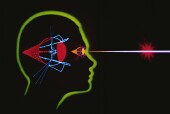
TUESDAY, April 12 (HealthDay News) — When children who were blind from birth were able to see for the first time, they weren’t immediately able to make the connection between what they were seeing and what they were feeling with their hands, a new study reveals.
However, they gained that ability within a few days.
The findings suggest that the brain doesn’t have a natural ability to make a connection between different types of sensory input but can quickly learn that skill, Pawan Sinha, a professor in the brain and cognitive sciences department at Massachusetts Institute of Technology, said in an MIT news release.
The study included five children, aged 8 to 17, in India who were born blind. Four of them had congenital cataracts and one had corneal opacity. They underwent surgery to correct their eye problems.
The patients’ ability to make the connection between what they were seeing and what they were feeling with their hands was tested within 48 hours after surgery, shortly after their eye bandages were removed.
The study was published in the April 10 online edition of the journal Nature Neuroscience.
The brain appears to learn to make connections between different types of sensory input by analyzing the timing of each stimulus, the researchers said. An example would be looking at your cell phone upon hearing it ring.
“The brain essentially has to look at the time sequence and figure out the correspondence,” Sinha said.
More information
The U.S. National Eye Institute has more about cataracts.

